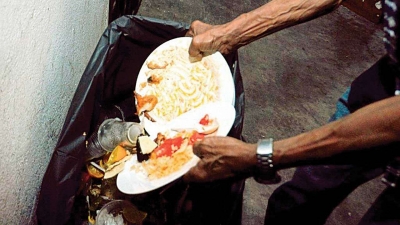
More than 930 million tonnes of food sold in 2019 landed in waste bins, according to the Food Waste Index Report 2021, released by the United Nations last month. The report reveals that 17% of all food is just dumped. Some food is also lost on farms and in supply chains, indicating that overall a third of food is never eaten. The study reveals that households discard 11% of food at the consumption stage of the supply chain, while food services and retail outlets waste 5% and 2%, respectively. The household food waste in India is about 68.7 million tonnes a year and average of 50 kg per person per year. The report looked at food waste that occurs in retail outlets, restaurants and homes-counting both food and inedible parts like bones and shells and presents the most comprehensive food waste data collection, analysis and modelling to date.
Hunger on the rise
On the one side, we waste so much of food, and on the other, scores of people are dying of hunger every day. In 2019, some 690 million people were impacted by hunger and three billion were unable to afford a healthy diet, says the report. According to the United Nations Food and Agriculture Organisation (FAO), globally, one in three persons is not getting the right food in right quantity.
By dumping uneaten food from our plate, by buying in excess and leaving dishes to rot in the fridge, we waste quite a lot of food as consumers. There are also other ways through which food is lost throughout the supply chain from production to consumption. These include loss due to problems in harvesting, storage and packing and the accidental dropping of perishable goods during transportation, etc.
Why is it a matter of concern?
Food waste has substantial environmental, social and economic impacts. When you dump a container of previous night’s leftover, you are not just throwing away food, but all the resources that went into producing it, including effort, energy, water and fuel.
Food waste translates to an enormous amount of water wastage. According to the FAO’s Food Wastage Footprint report 2018, 250 km3 of water is used each year to produce food that is ultimately lost or wasted.. Similarly, 1.4 billion hectares of land 28 per cent of the world’s agricultural area is used annually to produce food that is lost or wasted.
Food waste that ends up in landfills produces a large amount of methane – a powerful greenhouse gas.
According to an estimate, if food waste were a country, it would be the third largest greenhouse gas emitter next to China and the United States.
How to reduce food waste
- Make a grocery list before you go shopping and stick to the list. Be careful when buying in bulk, especially with items that have a limited shelf life.
- Ensure you consume the product before the expiry date.
- Be careful with how much you take on your plate. If you need more, you can always go for a second helping.
- Sometimes vegetables and fruits that have dents or physical imperfection may not be rotten. Check before discarding.
- When eating out, request a takeaway, instead of leaving it on your plate. You may want to consume it later or share with it someone who may need it.
- Always look for options to reuse or recycle food.
- Donate excess food to a food bank.
- Each one of us – right from farmers, food processors, retailers, people involved in the storage and transportation of food, and consumers-should act responsibly to prevent food wastage.
Picture Credit : Google



